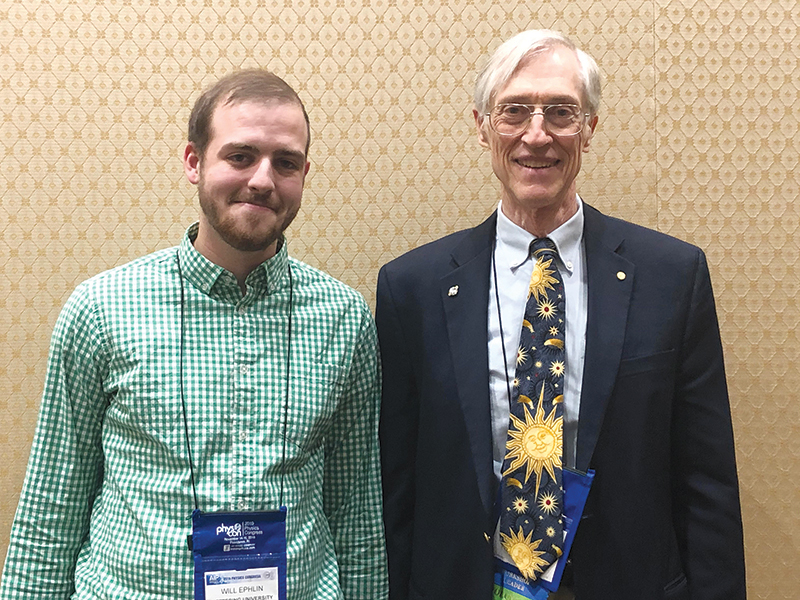The Man Who Helped Unlock Our Past Looks to the Future
Spring
2020
Feature
The Man Who Helped Unlock Our Past Looks to the Future
Will Ephlin, SPS Member, Kettering University
 Before he won the 2006 Nobel Prize in Physics, before he was the project scientist for the James Webb Space Telescope, before he was listed as one of Time magazine’s 100 Most Influential People in the World, and before he helped to provide irrefutable evidence that the big bang theory explains our universe’s origin, something that Stephen Hawking called “the discovery of the century, if not all time”—before any of that—John C. Mather was just a curious young boy.
Before he won the 2006 Nobel Prize in Physics, before he was the project scientist for the James Webb Space Telescope, before he was listed as one of Time magazine’s 100 Most Influential People in the World, and before he helped to provide irrefutable evidence that the big bang theory explains our universe’s origin, something that Stephen Hawking called “the discovery of the century, if not all time”—before any of that—John C. Mather was just a curious young boy.
It was the 1950s in Upper Manhattan, and an adolescent Mather was taking in all he could at New York’s Museum of Natural History. The walls were decorated with ancient dinosaur bones and long-dormant chunks of volcanic rock. On display for all to see were colossal fish skeletons, aligned so that the process of evolution was evident. It was a stunningly blatant message that nature is never done being discovered. That quest captivated Mather.
Today he’s a world-renowned astrophysicist who has helped to explain one of the universe’s most fundamental questions, but that memory of silently studying the hunks of rock and bone that adorn the museum’s walls might be more important to him than any lecture or book.
Mather’s father, Robert E. Mather, was a geneticist pursuing research in animal husbandry and statistics, specifically focusing on dairy cattle. As a boy, Mather remembers his father explaining the nature of living things to him. “I was about six, and a bedtime story one night was that living things are made from cells, and they have chromosomes in them, and they control what’s going to happen. If you’re six and you hear that story, you think, Well, of course it probably is like that....Pretty soon you say, That’s really exciting, I want to know more.’”
This curiosity continued well into primary school and beyond. At the time, Mather couldn’t name what it was that he wanted to do, but he knew that explaining the universe interested him. “It makes you think about everything around you, all the people around you, what different luck we all have ... It’s all connected. We don’t start at the same point, but we all change.”
I sat down with Mather during the 2019 PhysCon in Providence, Rhode Island, to ask him about his past and present, and I was pleasantly surprised at how much he referenced the future. Throughout our interview, his eyes took me to distant galaxies and faraway planets, still full of the childlike wonder that captivates so many aspiring physicists.
Mather’s achievements can be credited to years of careful research, but according to him, the origin of the project that would eventually earn him a Nobel Prize is something Mather refers to frequently when discussing the realm of science—pure luck. “I wandered around the physics department and asked professors what they had to work on; I had to find a thesis,” Mather says. “So, these folks are going to work on measuring the big bang with cosmic microwave background radiation. Oh okay, I like that, can I work with you? And that’s how it started.”
 I then asked Mather about the growth of modern technology. This is a topic that seems omnipresent in Mather’s mind and was a key point of his plenary talk later that night. “I’m not scared, but I think bad stuff is happening already—you can see it. We are in an exponential growth phase of human society. Exponential growth doesn’t continue forever.” He says this with a calm acceptance. There are hazards and pitfalls along the path to prosperity, but Mather is comfortable accepting those. I ask him if he thinks this growth is good, and after a long pause, he responds, “You can’t ask Pandora to put her box back...she won’t.”
I then asked Mather about the growth of modern technology. This is a topic that seems omnipresent in Mather’s mind and was a key point of his plenary talk later that night. “I’m not scared, but I think bad stuff is happening already—you can see it. We are in an exponential growth phase of human society. Exponential growth doesn’t continue forever.” He says this with a calm acceptance. There are hazards and pitfalls along the path to prosperity, but Mather is comfortable accepting those. I ask him if he thinks this growth is good, and after a long pause, he responds, “You can’t ask Pandora to put her box back...she won’t.”
The past is an important keystone in Mather’s viewpoint of the future, and he frequently references legends of scientific lore when discussing how to proceed on difficult projects. “People are storytelling creatures,” he says, cracking a smile. “They remember what you tell them in stories much more than they will facts. So, give them stories.”
When I asked him what stories inspired him as a youngster, I was surprised that they were tales of risk and peril. “The fact that Darwin and Galileo were persecuted for their discoveries, that made [science] important to me. [I realized] that opposition is a sign of importance,” he says. This mindset has stayed with him. “When somebody [in] Congress says that they don’t like [a scientific finding], it just proves how important it was that we did it, to me. So, we keep on going.”
This type of inspirational, motivating point of view is what truly amazed me about Mather. He’s reached the pinnacle of achievement in physics—he is a Nobel laureate, winner of the prestigious Robinson Prize in Cosmology, and the tip of the spear for NASA’s latest and greatest extraplanetary satellite. Yet he shows humility, and above all else, the desire for his work to continue. To him it’s not about awards or recognition. It’s about making a better world, despite the challenges. Pandora’s box may never close, but perhaps the act of opening it will help us find what we’re looking for.
As we stand up to collect our things after the interview, Mather leaves me with truly profound advice. “Our job as scientists is to work on the unsolved problems. It’s always terribly discouraging, because every day you work on the things you don’t know about. Once in a while you solve something, but then it is immediately back to the part you don’t know yet. So, you have to be tolerant of ‘I don’t know.’ It’s scary... but it’s thrilling.”
